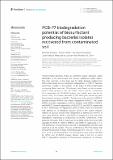Por favor, use este identificador para citar o enlazar a este item:
http://hdl.handle.net/10261/283955COMPARTIR / EXPORTAR:
 SHARE SHARE
 CORE
BASE CORE
BASE
|
|
| Visualizar otros formatos: MARC | Dublin Core | RDF | ORE | MODS | METS | DIDL | DATACITE | |

| Título: | PCB-77 biodegradation potential of biosurfactant producing bacterial isolates recovered from contaminated soil |
Autor: | Sandhu, Monika; Paul, Atish T.; Proćków, Jarosław; Pérez de Lastra, José Manuel CSIC ORCID ; Jha, Prabhat N. | Palabras clave: | Polychlorinated biphenyl Biodegradation Biosurfactant Pseudomonas aeruginosa Pseudomonas plecoglossicida Priestia megaterium Brucella anthropi |
Fecha de publicación: | 26-sep-2022 | Editor: | Frontiers Media | Citación: | Frontiers in Microbiology 13: 952374 (2022) | Resumen: | Polychlorinated biphenyls (PCBs) are persistent organic pollutants widely distributed in the environment and possess deleterious health effects. The main objective of the study was to obtain bacterial isolates from PCB-contaminated soil for enhanced biodegradation of PCB-77. Selective enrichment resulted in the isolation of 33 strains of PCB-contaminated soil nearby Bhilai steel plant, Chhattisgarh, India. Based on the prominent growth using biphenyl as the sole carbon source and the confirmation of its degradation by GC-MS/MS analysis, four isolates were selected for further study. The isolates identified by 16S rRNA gene sequencing were Pseudomonas aeruginosa MAPB-2, Pseudomonas plecoglossicida MAPB-6, Brucella anthropi MAPB-9, and Priestia megaterium MAPB-27. The isolate MAPB-9 showed a degradation of 66.15% biphenyl, while MAPB-2, MAPB-6, and MAPB-27 showed a degradation of 62.06, 57.02, and 56.55%, respectively in 48 h. Additionally, the degradation ability of these strains was enhanced with addition of co-metabolite glucose (0.2%) in the culture medium. Addition of glucose showed 100% degradation of biphenyl by MAPB-9, in 48 h, while MAPB-6, MAPB-2, and MAPB-27 showed 97.1, 67.5, and 53.3% degradation, respectively as analyzed by GC-MS/MS. Furthermore, in the presence of inducer, PCB-77 was found to be 59.89, 30.49, 27.19, and 4.43% degraded by MAPB-6, MAPB-9, MAPB-2, and MAPB-27, respectively in 7 d. The production of biosurfactants that aid in biodegradation process were observed in all the isolates. This was confirmed by ATR-FTIR analysis that showed the presence of major functional groups (CH2, CH3, CH, = CH2, C–O–C, C-O) of the biosurfactant. The biosurfactants were further identified by HPTLC and GC-MS/MS analysis. Present study is the first to report PCB-77 degradation potential of Pseudomonas aeruginosa, B. anthropi, Pseudomonas plecoglossicida, and Priestia megaterium. Similarly, this is the first report on Pseudomonas plecoglossicida and Priestia megaterium for PCB biodegradation. Our results suggest that the above isolates can be used for the biodegradation of biphenyl and PCB-77 in PCB-contaminated soil. | Versión del editor: | https://doi.org/10.3389/fmicb.2022.952374 | URI: | http://hdl.handle.net/10261/283955 | DOI: | 10.3389/fmicb.2022.952374 | E-ISSN: | 1664-302X |
| Aparece en las colecciones: | (IPNA) Artículos |
Ficheros en este ítem:
| Fichero | Descripción | Tamaño | Formato | |
|---|---|---|---|---|
| fmicb-13-952374.pdf | 3,66 MB | Adobe PDF |  Visualizar/Abrir |
CORE Recommender
SCOPUSTM
Citations
7
checked on 26-abr-2024
WEB OF SCIENCETM
Citations
3
checked on 22-feb-2024
Page view(s)
82
checked on 29-abr-2024
Download(s)
115
checked on 29-abr-2024
Google ScholarTM
Check
Altmetric
Altmetric
Este item está licenciado bajo una Licencia Creative Commons

